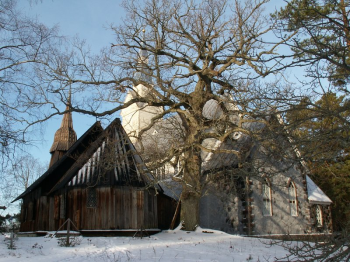Ruhnu rural municipality 



Ruhnu rural municipality, a second phase administrative unit formed on 19 December 1991, located on the island of the same name in the Gulf of Liivi, it also covers some ten tiny islands located in the west coast sea of Ruhnu, which Saare county also belongs to; Ruhnu village is the centre. The island has a border guard cordon.
Concerning population, it is one of the smallest municipalities in Estonia together with Tartumaa Piirissaare municipality.
Population
During the census of population of 2011, there were 55 (29 men and 26 women) people from who 51 were Estonians. Eleven years ago, during the census of population of 2000, 67 people (31 men and 36 women) lived in Ruhnu from who 62 were Estonians. Ruhnu has a great percentage of young people. During the last years it has been the parish in Estonia with one of the biggest percentage of young people under age of 29 (29%), and smallest percentage of people older than 65 (11%).
Until 4 August 1944, the island was mainly settled by coastal Swedes, after that by Estonians from Kihnu, Saaremaa and other places. The settlement (the only village Ruhnu) is situated in the middle of the island. Population was highest in 1842 – 389 souls (207 men and 182 women).
Economy and transportation
Majority of adult population are secured with jobs, the biggest employer is the public sector, tourism is also becoming more active. The island has 2 all-the-year-round shops, 5 five households are offering board and bed for tourists in farmhouses, a rental sauna on Limo beach (see Ruhnu tourist farms), as well as the Estonian Post's Ruhnu franchise. In the southern part of the island near Ringsu cape, there is a weather station, airport, diesel electric power station and harbour.
Six families are active in agriculture – beekeeping, cattle and sheep breeding and forage storing. There are almost 70 Estonian native cattles (from who 20 are cows), about Scottish Highland cattle, who maintain the island's southwest coastal meadows, and 40–50 sheep. All milk is used in Ruhnu for the preparation of soir, curd, cheese, butter, sour cream and in part the milk is fed as skim milk to young animals. Pigs (19), chickens (110) and bees (30 families) are also kept as domestic animals. From crops, oat and barley (ca 20 hectares) are grown in the biggest sown area, but wheat, rye and vegetables are also grown. Since 2007 professional fishing is again practised on Ruhnu island. Saaremaa forest district´s Kuressaare forest area manages the land of the national forest. The municipality’s budget in 2013 was 208,171 Euros from which 44% consisted of expenses of the educational and cultural sphere.
Read more about the limited liability company Ruhnu Services.
Education, health care and tourism
There is a basic school, museum, library and community and cultural centre house in Ruhnu village, Ruhnu St. Magdalene congregation operates in the village.
On 1 March 2012 an emergency help brigade under the management of North-Estonian Regional Hospital operates in Ruhnu.
The main island´s sightseeing places include the wooden church completed in 1644 (the oldest Estonian wooden building), new church located next to it and an old village graveyard surrounding them; the lighthouse (built in 1877, the height of the light is about 65 metres above the sea level) is an interesting place in the east of the village on Haubjerre hill and there are several preserved 17th-19th-century farm houses (Korsi farm, Bulders farm, Hollingers farm).
History
The island was the property of the state; sometimes considered as a state farm. The Ruhnu church manor (Pastorat Runö) was located near the church. In 1866 Ruhnu parish was formed in the service of Livonian district´s Saare county, which existed until 1950, the status was re-established on 19 December 1991. From 1950 until 12 December 1986, Ruhnu was in the service of Pärnumaa (Pärnu region of that time).
Read more about the history of Ruhnu
Related articles
- Ruhnu Island (overview of island's geography and nature)
- History of Ruhnu
- Life and work on Ruhnu
- Ruhnu and the sea
External link
Created in 2013






